Abstract
Choosing the best location for starting a business or expanding an existing enterprize is an important issue. A number of location selection problems have been discussed in the literature. They often apply the Reverse Nearest Neighbor as the criterion for finding suitable locations. In this paper, we apply the Average Distance as the criterion and propose the so-called k-most suitable locations (k-MSL) selection problem. Given a positive integer k and three datasets: a set of customers, a set of existing facilities, and a set of potential locations. The k-MSL selection problem outputs k locations from the potential location set, such that the average distance between a customer and his nearest facility is minimized. In this paper, we formally define the k-MSL selection problem and show that it is NP-hard. We first propose a greedy algorithm which can quickly find an approximate result for users. Two exact algorithms are then proposed to find the optimal result. Several pruning rules are applied to increase computational efficiency. We evaluate the algorithms’ performance using both synthetic and real datasets. The results show that our algorithms are able to deal with the k-MSL selection problem efficiently.



















Similar content being viewed by others
Notes
The Pascal’s Formula: \({|P| \choose k} = {|P|-1 \choose k} + {|P|-1 \choose k-1}\).
References
Du Y, Zhang D, Xia T (2005) The optimal-location query. In: Advances in Spatial and Temporal Databases. Springer, pp 163–180
Xia T, Zhang D, Kanoulas E, Du Y (2005) On computing top-t most influential spatial sites. In: Proceedings of the 31st international conference on Very large data bases. VLDB Endowment, pp 946–957
Wong RC-W, Özsu MT, Yu PS, Fu AW-C, Liu L (2009) Efficient method for maximizing bichromatic reverse nearest neighbor. Proc VLDB Endowment 2(1):1126–1137
Yan D, Wong RC-W, Ng W (2011) Efficient methods for finding influential locations with adaptive grids. In: Proceedings of the 20th ACM international conference on Information and knowledge management. ACM, pp 1475–1484
Wong RC-W, Özsu MT, Fu AW-C, Yu PS, Liu L, Liu Y (2011) Maximizing bichromatic reverse nearest neighbor for lp-norm in two-and three-dimensional spaces. VLDB J Int J Very Large Data Bases 20(6):893–919
Ghaemi P, Shahabi K, Wilson JP, Banaei-Kashani F (2010) Optimal network location queries. In: Proceedings of the 18th SIGSPATIAL International Conference on Advances in Geographic Information Systems. ACM, pp 478–481
Zhou Z, Wu W, Li X, Lee ML, Hsu W Maxfirst for maxbrknn. In: 2011 IEEE 27th International Conference on Data Engineering (ICDE). IEEE, pp 828–839, vol 2011
Zheng K, Huang Z, Zhou A, Zhou X (2012) Discovering the most influential sites over uncertain data: A rank-based approach. IEEE Trans Knowl Data Eng 24 (12):2156–2169
Shang S, Yuan B, Deng K, Xie K, Zhou X (2011) Finding the most accessible locations: reverse path nearest neighbor query in road networks. In: Proceedings of the 19th ACM SIGSPATIAL International Conference on Advances in Geographic Information Systems. ACM, pp 181–190
Huang J, Wen Z, Qi J, Zhang R, Chen J, He Z (2011) Top-k most influential locations selection. In: Proceedings of the 20th ACM international conference on Information and knowledge management. ACM, pp 2377–2380
Chen J, Huang J, Wen Z, He Z, Taylor K, Zhang R (2015) Analysis and evaluation of the top-k most influential location selection query. Knowl Inf Syst 43 (1):181–217
Korn F, Muthukrishnan S (2000) Influence sets based on reverse nearest neighbor queries. In: ACM SIGMOD Record, vol 29. no. 2, ACM, pp 201–212
Korn F, Muthukrishnan S, Srivastava D (2002) Reverse nearest neighbor aggregates over data streams. In: Proceedings of the 28th international conference on Very Large Data Bases. VLDB Endowment, pp 814–825
Qi J, Zhang R, Kulik L, Lin D, Xue Y (2012) The min-dist location selection query. In: 2012 IEEE 28th International Conference on Data Engineering (ICDE). IEEE, pp 366–377
Zhang D, Du Y, Xia T, Tao Y (2006) Progressive computation of the min-dist optimal-location query. In: Proceedings of the 32nd international conference on Very large data bases. VLDB Endowment, pp 643–654
Xiao X, Yao B, Li F (2011) Optimal location queries in road network databases. In: 2011 IEEE 27th International Conference on Data Engineering (ICDE). IEEE, pp 804–815
Guha S, Khuller S (1999) Greedy strikes back: Improved facility location algorithms. J Algorithm 31(1):228–248
Korupolu MR, Plaxton CG, Rajaraman R (2000) Analysis of a local search heuristic for facility location problems. J Algorithm 37(1):146–188
Mouratidis K, Papadias D, Papadimitriou S (2005) Medoid queries in large spatial databases. In: Advances in Spatial and Temporal Databases. Springer, pp 55–72
Mouratidis K (2008) Tree-based partition querying: a methodology for computing medoids in large spatial datasets. VLDB J Int J Very Large Data Bases 17(4):923–945
Megiddo N, Supowit KJ (1984) On the complexity of some common geometric location problems. SIAM J Comput 13(1):182–196
Mettu RR, Plaxton CG (2003) The online median problem. SIAM J Comput 32(3):816–832
Garey MR, Johnson DS (1979) Computers and intractability: a guide to the theory of np-completeness. Freeman, San Francisco
Lee CY, Chung YC, Su I-F (2017) k-most suitable locations selection (tech report), Technical Report. http://web.cjcu.edu.tw/justim/TechReport_kMost090317.pdf
Cabello S, Díaz-Báñez JM, Langerman S, Seara C, Ventura I (2006) Reverse facility location problems: University of Ljubljana, Inst of Mathematics, Physics and Mechanics, Department of Mathematics
Guttman A (1984) R-trees: a dynamic index structure for spatial searching. In: Proceeding of the 1984 ACM SIGMOD international conference on management of data. Boston, Massachusetts, pp 47–57
Spatial (geographical) datasets in 2d space north america (2012) http://chorochronos.datastories.org/
Author information
Authors and Affiliations
Corresponding author
Rights and permissions
About this article
Cite this article
Chung, YC., Su, IF. & Lee, C. k-most suitable locations selection. Geoinformatica 22, 661–692 (2018). https://doi.org/10.1007/s10707-018-0318-5
Received:
Revised:
Accepted:
Published:
Issue Date:
DOI: https://doi.org/10.1007/s10707-018-0318-5




